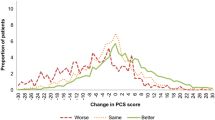Abstract
Background: We developed a tool, the Surgical Recovery Index (SRI), specifically to measure surgical recovery. We then tested the ability of the SRI to discriminate between patients undergoing laparoscopic (L) operations and patients undergoing open (O) operations. Methods: We surveyed 50 patients drawn from the practice of a single surgeon to establish the types of activities that define recovery from surgery. Their responses were used to construct the SRI, a self-administered questionnaire using a numerical rank-order scale format. A total score and two subscale scores (pain and activity resumption) were calculated for each patient. Mean and median scores were calculated for each patient group. Chi-square tests were used to evaluate group differences for individual questions; t-tests and Kruskal-Wallis tests were used to evaluate group differences for summary scores. Results: In all, 149 patients completed the SRI (60 L, 89 O). Cronbach’s alphas were 0.91 for pain questions and 0.97 for activity resumption questions. The scores for pain level with time (L vs O, 1–10 scale) at week 1 (mean, 4.42 vs 6.06, p = 0.03), week 2 (mean, 3.08 vs 4.38, p = 0.04), week 3 (mean, 2.03 vs 3.16, p = 0.02), and week 4 (mean, 1.18 vs 2.28, p = 0.00) all favored laparoscopy. The scores for pain level with activity (L vs O, 1–3 scale) for getting out of bed (mean, 1.62 vs 1.85, p = 0.04), hygiene activities (mean, 1.38 vs 1.65, p = 0.04), and computer work (mean, 1.15 vs 1.56, p = 0.00) were all significant, although pain with exertion (mean, 1.87 vs 2.10, p = 0.13) was not. Delay until return to activity (L vs O, 1–4 scale) was significant, favoring L for 13 activities (all p < 0.02), but it was not significant for three activities. The scores for subscales for pain (L vs O, mean, 20.7 vs 34.4, respectively) and activity resumption delay (mean, 44.3 vs 62.0), as well as total scores (mean, 33.0 vs 49.0), were also significant (all p = 0.00). The same differences were observed when median scores were considered instead of mean scores, suggesting the robustness of the group difference. Conclusions: Reduction in time to full recovery (i.e., pain resolution and activity resumption) is a fundamental advantage of laparoscopic surgery, yet there are no tools designed to specifically measure recovery. These data provide preliminary evidence of the reliability and validity of the new SRI as a measure of recovery in patients undergoing laparoscopic operations.
Similar content being viewed by others
References
M Bergner RA Bobbitt WB Carter BS Gilson (1981) ArticleTitleThe Sickness Impact Profile: development and final revision of a health status measure. Med Care 19 787–805 Occurrence Handle1:STN:280:Bi2D3M3is1Q%3D Occurrence Handle7278416
U Berggren N Zethraeus D Arvidsson U Haglund B Jonsson (1996) ArticleTitleA cost-minimization analysis of laparoscopic cholecystectomy versus open cholecystectomy. Am J Surg 172 305–310 Occurrence Handle10.1016/S0002-9610(96)00197-3 Occurrence Handle1:STN:280:ByiD38jjsl0%3D Occurrence Handle8873518
M Borstlap JL Zant RM van Soesbergen JK van der Korst (1995) ArticleTitleQuality of life assessment: a comparison of four questionnaires: for measuring improvements after total hip replacement. Clin Rheumatol 14 15–20 Occurrence Handle1:STN:280:ByqB283js1Y%3D Occurrence Handle7743739
MM Cohen W Young ME Theriault R Hernandez (1996) ArticleTitleHas laparoscopic cholecystectomy changed patterns of practice and patient outcome in Ontario? Can Med Assoc J 155 161–162
JJ Huang CJ Yeo TA Sohn KD Lillemoe PK Sauter J Coleman RH Hruban JL Cameron (2000) ArticleTitleQuality of life and outcomes after pancreaticoduodenectomy. Ann Surg J 231 890–898 Occurrence Handle10.1097/00000658-200006000-00014 Occurrence Handle1:STN:280:DC%2BD3c3nslymtg%3D%3D
RL Kane N Lurie C Borbas et al. (1995) ArticleTitleThe outcomes of elective laparoscopic and open cholecystectomies. J Am Coll Surg 180 136–145 Occurrence Handle1:STN:280:ByqC2M3ovVI%3D Occurrence Handle7850045
JE Kelley RG Burrus RP Burns LD Graham KE Chandler (1993) ArticleTitleSafety, efficacy, cost, and morbidity of laparoscopic versus open cholecystectomy: a prospective analysis of 228 consecutive patients. Am Surg 59 23–27 Occurrence Handle1:STN:280:ByyB2czlslE%3D Occurrence Handle8480927
A Lassen C Jenkison R Fitzpatrick T Goodacre (1998) ArticleTitleMeasuring quality of life in cosmetic surgery patients with a condition-specific instrument: the Derriford scale. Br J Plast Surg 51 380–384 Occurrence Handle10.1054/bjps.1997.0250 Occurrence Handle9771365
DP McKellar RM Johnson JA Dutro J Mellinger WA Bernie JB Peoples (1995) ArticleTitleCost-effectiveness of laparoscopic cholecystectomy. Surg Endosc 9 158–162 Occurrence Handle1:STN:280:ByqA38%2FnsVE%3D Occurrence Handle7597585
SP McKenna LC Doward D Whalley (1998) ArticleTitleThe development and testing of the Well-being Index for Surgical Patients (WISP). Qual Life Res 7 167–173 Occurrence Handle10.1023/A:1008861627541 Occurrence Handle1:STN:280:DyaK1c7osVSquw%3D%3D Occurrence Handle9523498
CM Mangione L Goldman EJ Orav ER Marcantonio A Pedan LE Ludwig MC Donaldson DJ Sugarbaker R Poss TH Lee (1997) ArticleTitleHealth-related quality of life after elective surgery: measurement of longitudinal changes. J Gen Intern Med 12 686–697
NJ Soper PT Stockmann DL Dunnegan et al. (1992) ArticleTitleLaparoscopic cholecystectomy: the new “gold standard”? Arch Surg 127 917–921 Occurrence Handle1:STN:280:By2A2M3jtVQ%3D Occurrence Handle1386505
CA Steiner EB Bass MA Talamini et al. (1994) ArticleTitleSurgical rates and operative mortality for open and laparoscopic cholecystectomy in Maryland. N Engl J Med 330 404–408 Occurrence Handle10.1056/NEJM199402103300607
JE Ware KK Snow M Kosinski (1993, 2000) SF-36® health survey: manual and interpretation guide. QualityMetric Lincoln (RI)
J Wenner H Graffner G Lindell (1995) ArticleTitleA financial analysis of laparoscopic and open cholecystectomy. Surg Endosc J 9 702 Occurrence Handle1:STN:280:BymD2srot10%3D
AW Wu (2000) Patient-reported outcomes measures. TA Gordon JL Cameron (Eds) Evidence-based surgery. BC Decker Hamilton 221–237
Acknowledgments
This work was supported by a grant from US Surgical Corporation (Norwalk, CT, USA), a division of Tyco Healthcare.
Author information
Authors and Affiliations
Corresponding author
Rights and permissions
About this article
Cite this article
Talamini, M., Stanfield, C., Chang, D. et al. The surgical recovery index. Surg Endosc 18, 596–600 (2004). https://doi.org/10.1007/s00464-002-8962-z
Received:
Accepted:
Published:
Issue Date:
DOI: https://doi.org/10.1007/s00464-002-8962-z




